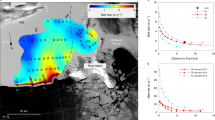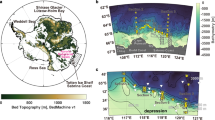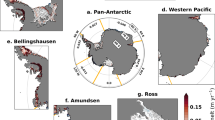Abstract
Mass loss from the Antarctic Ice Sheet to the ocean has increased in recent decades, largely because the thinning of its floating ice shelves has allowed the outflow of grounded ice to accelerate1,2. Enhanced basal melting of the ice shelves is thought to be the ultimate driver of change2,3, motivating a recent focus on the processes that control ocean heat transport onto and across the seabed of the Antarctic continental shelf towards the ice4,5,6. However, the shoreward heat flux typically far exceeds that required to match observed melt rates2,7,8, suggesting that other critical controls exist. Here we show that the depth-independent (barotropic) component of the heat flow towards an ice shelf is blocked by the marked step shape of the ice front, and that only the depth-varying (baroclinic) component, which is typically much smaller, can enter the sub-ice cavity. Our results arise from direct observations of the Getz Ice Shelf system and laboratory experiments on a rotating platform. A similar blocking of the barotropic component may occur in other areas with comparable ice–bathymetry configurations, which may explain why changes in the density structure of the water column have been found to be a better indicator of basal melt rate variability than the heat transported onto the continental shelf9. Representing the step topography of the ice front accurately in models is thus important for simulating ocean heat fluxes and induced melt rates.
This is a preview of subscription content, access via your institution
Access options
Access Nature and 54 other Nature Portfolio journals
Get Nature+, our best-value online-access subscription
$29.99 / 30 days
cancel any time
Subscribe to this journal
Receive 51 print issues and online access
$199.00 per year
only $3.90 per issue
Buy this article
- Purchase on Springer Link
- Instant access to full article PDF
Prices may be subject to local taxes which are calculated during checkout




Similar content being viewed by others
Data availability
The mooring data analysed during the current study (raw data for Figs. 1, 2 and Extended Data Figs. 1–6) are available at the Norwegian Marine Data Centre (https://doi.org/10.21335/NMDC-1721053841, GW1, 2)40 and at the SOOS database at NODC (https://doi.org/10.25921/n07g-f935 and https://doi.org/10.25921/6pwp-1791, GW3). Raw data obtained from the PIV calculations (raw data for Fig. 4 and Extended Data Fig. 9) are available at Zenodo (https://zenodo.org/record/3543624).
Code availability
The PIV calculations were conducted with the matlab software UVMAT developed at LEGI available at http://servforge.legi.grenoble-inp.fr/projects/soft-uvmat. Independent results were also obtained with the MatPIV package available at https://www.mn.uio.no/math/english/people/aca/jks/matpiv.
References
Shepherd, A., Fricker, H. A. & Farrell, S. L. Trends and connections across the Antarctic cryosphere. Nature 558, 223–232 (2018).
Pritchard, H. D. et al. Antarctic ice-sheet loss driven by basal melting of ice shelves. Nature 484, 502–505 (2012).
Liu, Y. et al. Ocean-driven thinning enhances iceberg calving and retreat of Antarctic ice shelves. Proc. Natl Acad. Sci. USA 112, 3263–3268 (2015).
Thoma, M., Jenkins, A., Holland, D. & Jacobs, S. Modelling Circumpolar Deep Water intrusions on the Amundsen Sea continental shelf, Antarctica. Geophys. Res. Lett. 35, L18602 (2008).
Wåhlin, A. K. et al. Some implications of Ekman layer dynamics for cross-shelf exchange in the Amundsen Sea. J. Phys. Oceanogr. 42, 1461–1474 (2012).
Darelius, E., Fer, I. & Nicholls, K. W. Observed vulnerability of Filchner-Ronne Ice Shelf to wind-driven inflow of warm deep water. Nat. Commun. 7, 12300 (2016).
Palóczy, A., Gille, S. T. & McClean, J. L. Oceanic heat delivery to the Antarctic continental shelf: large-scale, low-frequency variability. J. Geophys. Res. 123, 7678–7701 (2018).
Assmann, K. M., Darelius, E., Wåhlin, A. K., Kim, T. W. & Lee, S. H. Warm Circumpolar Deep Water at the western Getz Ice Shelf front, Antarctica. Geophys. Res. Lett. 46, 870–878 (2019).
Jenkins, A. et al. West Antarctic Ice Sheet retreat in the Amundsen Sea driven by decadal oceanic variability. Nat. Geosci. 11, 733–738 (2018).
IPCC. Climate Change 2014: Synthesis Report. Contribution of Working Groups I, II and III to the Fifth Assessment Report of the Intergovernmental Panel on Climate Change (eds Pachauri R. K. & Meyer L. A.) (IPCC, 2014).
IMBIE Team. Mass balance of the Antarctic ice sheet from 1992 to 2017. Nature 558, 219–222 (2018).
DeConto, R. M. & Pollard, D. Contribution of Antarctica to past and future sea-level rise. Nature 531, 591–597 (2016).
Scambos, T. A., Bohlander, J. A., Shuman, C. A. & Skvarca, P. Glacier acceleration and thinning after ice shelf collapse in the Larsen B embayment, Antarctica. Geophys. Res. Lett. 31, L18402 (2004).
Jenkins, A. et al. Observations beneath Pine Island Glacier in West Antarctica and implications for its retreat. Nat. Geosci. 3, 468–472 (2010).
Callahan, J. E. The structure and circulation of Deep Water in the Antarctic. Deep-Sea Res. 19, 563–575 (1972).
Thompson, A. F., Stewart, A. L., Spence, P. & Heywood, K. J. The Antarctic Slope Current in a changing climate. Rev. Geophys. 56, 741–770 (2018).
Depoorter, M. A. et al. Calving fluxes and basal melt rates of Antarctic ice shelves. Nature 502, 89–92 (2013); correction 502, 580 (2013).
Wåhlin, A. K., Yuan, X., Björk, G. & Nohr, C. Inflow of Warm Circumpolar Deep Water in the Central Amundsen Shelf. J. Phys. Oceanogr. 40, 1427–1434 (2010).
Herraiz-Borreguero, L. et al. Circulation of modified Circumpolar Deep Water and basal melt beneath the Amery Ice Shelf, East Antarctica. J. Geophys. Res. Oceans 120, 3098–3112 (2015).
Nakayama, Y., Menemenlis, D., Zhang, H., Schodlok, M. & Rignot, E. Origin of Circumpolar Deep Water intruding onto the Amundsen and Bellingshausen Sea continental shelves. Nat. Commun. 9, 1–9 (2014).
St-Laurent, P., Klinck, J. M. & Dinniman, M. S. On the role of coastal troughs in the circulation of warm Circumpolar Deep Water on Antarctic shelves. J. Phys. Oceanogr. 43, 51–64 (2013).
Cushman-Roisin, B. & Beckers, J.-M. Introduction to Geophysical Fluid Dynamics: Physical and Numerical Aspects (Prentice-Hall, 2011).
Nof, D. The translation of isolated cold eddies on a sloping bottom. Deep-Sea Res. A 30, 171–182 (1983).
Wåhlin, A. K. Topographic advection of dense bottom water. J. Fluid Mech. 510, 95–104 (2004).
Ha, H. K. et al. Circulation and modification of warm deep water on the central Amundsen shelf. J. Phys. Oceanogr. 44, 1493–1501 (2014).
Wåhlin, A. K. et al. Variability of warm deep water inflow in a submarine trough on the Amundsen Sea shelf. J. Phys. Oceanogr. 43, 2054–2070 (2013).
Kalén, O. et al. Is the oceanic heat flux on the central Amundsen sea shelf caused by barotropic or baroclinic currents? Deep-Sea Res. II 123, 7–15 (2016).
Rignot, E., Jacobs, S., Mouginot, J. & Scheuchl, B. Ice-shelf melting around Antarctica. Science 341, 266–270 (2013).
Grosfeld, K., Gerdes, R. & Determann, J. Thermohaline circulation and interaction between ice shelf cavities and the adjacent open ocean. J. Geophys. Res. Oceans 102, 15595–15610 (1997).
Jacobs, S. et al. Getz Ice Shelf melting response to changes in ocean forcing. J. Geophys. Res. Oceans 118, 4152–4168 (2013).
Arndt, J. E. et al. The International Bathymetric Chart of the Southern Ocean (IBCSO) Version 1.0 — A new bathymetric compilation covering circum-Antarctic waters. Geophys. Res. Lett. 40, 3111–3117 (2013).
Little, C. M., Gnanadesikan, A. & Oppenheimer, M. How ice shelf morphology controls basal melting. J. Geophys. Res. 114, C12007 (2009).
Miles, T. et al. Glider observations of the Dotson Ice Shelf outflow. Deep-Sea Res. II 123, 16–29 (2016).
Nicholls, K. W. et al. Measurements beneath an Antarctic ice shelf using an autonomous underwater vehicle. Geophys. Res. Lett. 33, L08612 (2006).
Gade, H. Melting of ice in sea water: a primitive model with application to the Antarctic ice shelf and icebergs. J. Phys. Oceanogr. 9, 189–198 (1979).
Taylor, J. A. & Jonas, A. M. Maximising data return: towards a quality control strategy for managing and processing TRDI ADCP data sets from moored instrumentation. In 2008 IEEE/OES 9th Working Conference on Current Measurement Technology 80–88 (IEEE, 2008); available at https://doi.org/10.1109/CCM.2008.4480848 (2008).
IOC, SCOR & IAPSO. The International Thermodynamic Equation of Seawater, 2010: Calculation and Use of Thermodynamic Properties. IOC Manuals and Guides No. 56 (UNESCO, 2010).
Wesche, C., Jansen, D. & Dierking, W. Calving fronts of Antarctica: mapping and classification. Remote Sens. 5, 6305–6322 (2013).
Fofonoff, N. P. & Millard, R. C. Algorithms for Computation of Fundamental Properties of Seawater. UNESCO Technical Papers in Marine Science 44 (UNESCO, 1983).
Darelius, E., Fer, I., Assmann, K. & Kim, T. W. Physical oceanography from Mooring UiB1 and UiB4 in the Amundsen Sea. https://doi.org/10.21335/NMDC-1721053841 (University of Bergen, 2018).
Acknowledgements
Our experiments were supported by the European Union’s H2020 programme through the grant to Hydralab-plus, contract number 654110. We gratefully acknowledge grant support for the authors as follows: E.D. and N.S. from the Norwegian Research Council through grants 267660 (TOBACO) and 231549 (WARM); A.J. from the UK Natural Environment Research Council through grant number NE/L013770/1 (FISS); A.K.W. from the Swedish Research Council and the Swedish Foundation for Strategic Research through the Swedish Maritime Robotics Center (SMaRC); T.W.K. from the Korea Polar Research Institute, grant KOPRI PE19060; and L.H.B. from the H2020 grant number 661015 and the Centre for Southern Hemisphere Oceans Research. We thank I. Fer for lending instrumentation for GW1 and GW2.
Author information
Authors and Affiliations
Contributions
A.K.W. proposed the research. A.K.W., N.S., E.D. and K.M.A. wrote the first draft. J.S. assisted with analyses and a repository of laboratory data. All authors contributed to the laboratory experiments, to data processing, and/or to the field work. A.K.W., N.S., S.V. and A.K.M. prepared the figures. All authors read and commented on the text.
Corresponding author
Ethics declarations
Competing interests
The authors declare no competing interests.
Additional information
Peer review information Nature thanks Ala Khazendar, Veronica Tamsitt and the other, anonymous, reviewer(s) for their contribution to the peer review of this work.
Publisher’s note Springer Nature remains neutral with regard to jurisdictional claims in published maps and institutional affiliations.
Extended data figures and tables
Extended Data Fig. 1 Two year time series of velocity and temperature from the GW1 mooring.
a–c, Time series of eastward velocity (a; in m s−1), northward velocity (b; in m s−1) and temperature (c; in °C) for the GW1 mooring. Black lines in c indicate positions of Microcats (instruments that measure temperature and salinity; thick lines) and SBE56 (instruments that measure temperature; thin lines).
Extended Data Fig. 2 Two year time series of velocity and temperature from the GW2 mooring.
a–c, Time series of eastward velocity (a; in m s−1), northward velocity (b; in m s−1) and temperature (c; in °C) for the GW2 mooring. Black lines in c indicate positions of Microcats (thick lines) and SBE56 (thin lines).
Extended Data Fig. 3 Two year time series of velocity and temperature from the GW3 mooring.
a–c, Time series of eastward velocity (a; in m s−1), northward velocity (b; in m s−1) and temperature (c; in °C) for the GW3 mooring. Black lines in c indicate positions of Microcats (thick lines) and SBE56 (thin lines).
Extended Data Fig. 4 Comparison of methods for calculating the barotropic current component.
a–c, Each panel shows the along-slope barotropic current component calculated in three ways (see Methods): blue curve, option (i), using the vertical average; red curve, option (ii), using the vertical average of the water more than 150 m above the seabed; and orange curve, option (iii), using the vertical average of water above the −0.5 °C isotherm. Three-day-averaged results are shown for mooring GW1 (a), mooring GW2 (b) and mooring GW3 (c).
Extended Data Fig. 5 The barotropic velocity is larger for GW1 and GW2 than GW3, the baroclinic velocity and the temperature increase towards the bottom.
a, Thick lines show average along-slope velocities as a function of distance above bottom, with colours indicating mooring (see key). Thin vertical lines show the barotropic components estimated according to method (i) (dotted lines), method (ii) (dashed lines), and method (iii) (solid lines). b, Baroclinic velocity components as a function of distance above bottom. c, Average temperature as a function of distance above bottom.
Extended Data Fig. 6 The barotropic heat flux component is larger than the baroclinic component for GW1 and GW2.
a–c, Each panel shows the time series of total heat flux (blue curve) and the barotropic and baroclinic components (respectively, red and orange curves) using equation (2) and definition (ii) of barotropic velocity, as described in Methods. a, Mooring GW1; b, mooring GW2; and c, mooring GW3.
Extended Data Fig. 7 Experiment set-up and dimensions.
a, Top view drawing of V-shaped channel (blue), ice shelf (white), camera views (PCO1, green; PCO2, orange) and the source (to scale). b, Side view drawing looking into the ice shelf facing south (right side in a). c, Side view drawing looking east (top of a). d–f, Top views of topography (grey scale bar indicates depth (in metres)) and water column thickness (coloured lines, labels, in metres) for ice shelf draughts of 0 cm (d), 30 cm, tilted (e), and 30 cm, horizontal (f).
Extended Data Fig. 8 Photographs of the experiments.
a, Top view showing the experimental set-up with the horizontal and vertical laser sheets. b, Technicians and students preparing for an experiment. c, Time series showing the ice shelf cavity filling up with dense water for the baroclinic experiments. d, Top view photograph showing a barotropic current moving towards the ice shelf. See Methods for details.
Extended Data Fig. 9 No blocking of depth-varying currents in laboratory.
a–i, Horizontal velocities from the laboratory experiments for baroclinic flow with the three different ice shelf configurations (Fig. 3b–d). Colours indicate velocity in the y direction, arrows indicate velocity vectors. a–c, Velocities at the horizontal plane in the centre of the current (black lines in d–i). d–f, Velocities at vertical sections underneath the ice shelf (green lines in a–c) and g–i in front of it (magenta lines in a–c). Dashed and shadowed rectangles indicate the ice shelf, grey shading indicates topography and grey lines are bathymetric lines that the current is expected to follow. White areas are not-measured or missing data. The cyan bar beneath the scale arrow in a–c indicate the temporal standard deviation of the velocity, and the magenta bar indicates the error (Methods).
Rights and permissions
About this article
Cite this article
Wåhlin, A.K., Steiger, N., Darelius, E. et al. Ice front blocking of ocean heat transport to an Antarctic ice shelf. Nature 578, 568–571 (2020). https://doi.org/10.1038/s41586-020-2014-5
Received:
Accepted:
Published:
Issue Date:
DOI: https://doi.org/10.1038/s41586-020-2014-5
This article is cited by
-
Ocean variability beneath Thwaites Eastern Ice Shelf driven by the Pine Island Bay Gyre strength
Nature Communications (2022)
-
Seasonal variability of ocean circulation near the Dotson Ice Shelf, Antarctica
Nature Communications (2022)
Comments
By submitting a comment you agree to abide by our Terms and Community Guidelines. If you find something abusive or that does not comply with our terms or guidelines please flag it as inappropriate.



